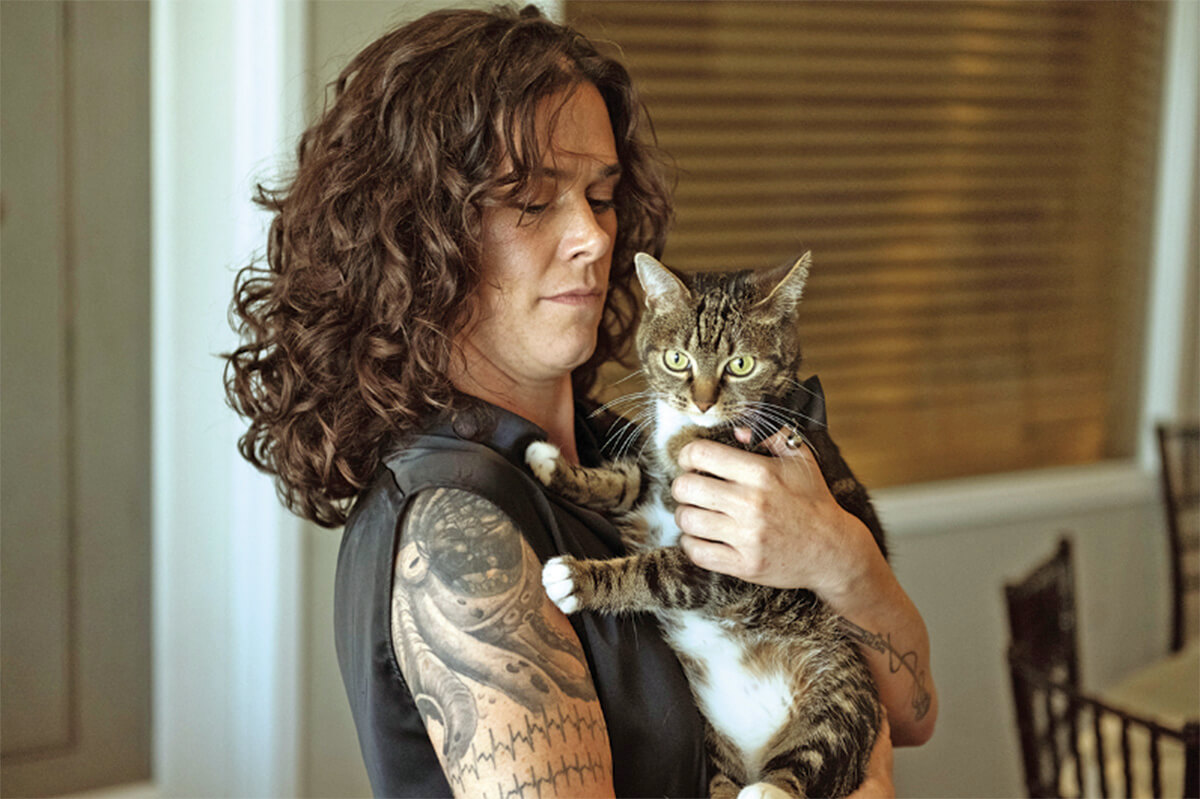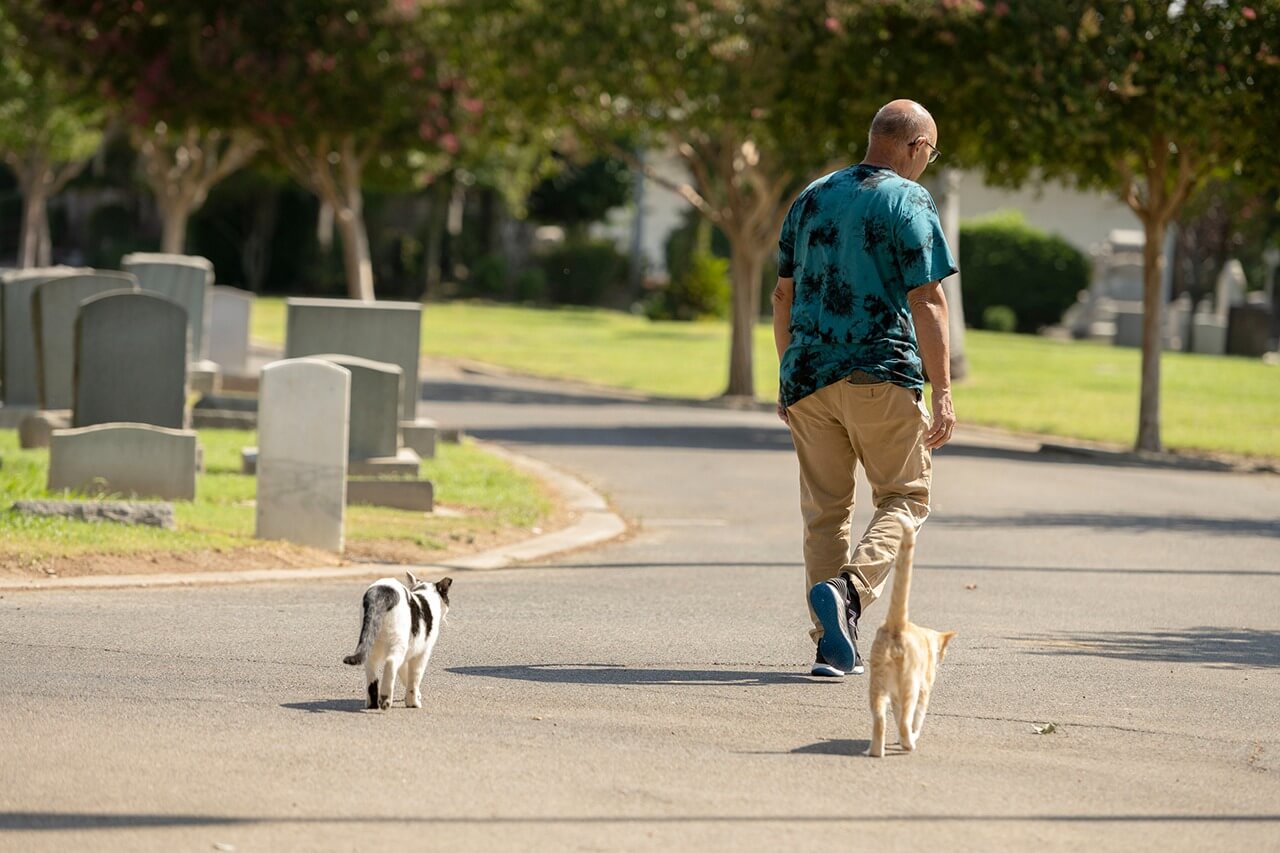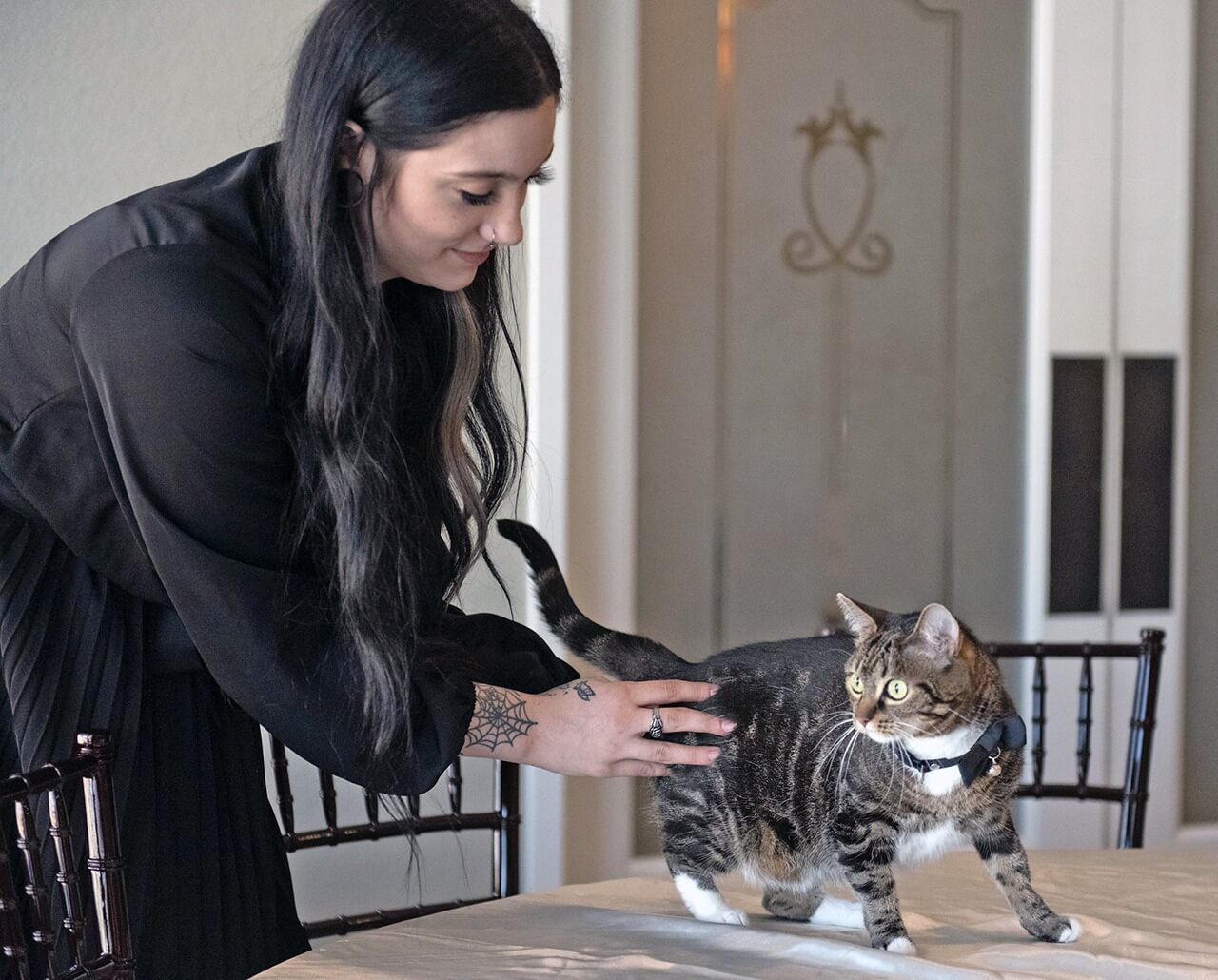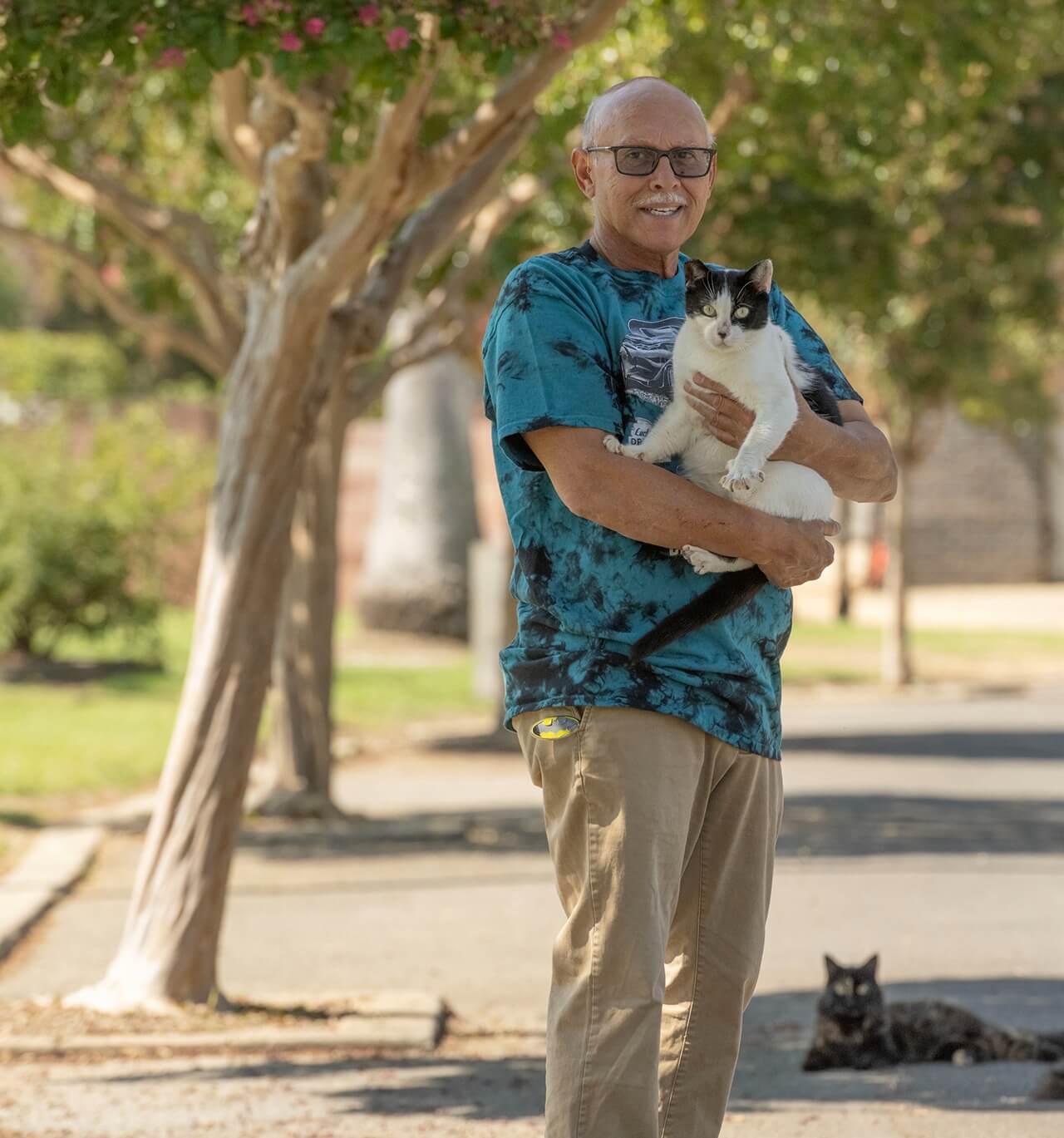Meet the Jewish funeral cats of Sacramento
Jewish mourning rituals offer a deeply rooted structure to guide a grieving family. And sometimes there’s a cat, too

Lana the cat and Rebekah Bzdick the human both work at Lombard Funeral Home, one of the primary funeral homes used by Sacramento-area Jews. Photo by Aaron Levy-Wolins
This article originally appeared in J. The Jewish News of Northern California, and was republished here with permission.
In the hours approaching midnight, Jason Lindo sat alone in the Lombard Funeral Home in Sacramento, reading psalms while performing shmira, the ritual guarding of the body before burial. It was someone he had adored, the 90-year-old Jewish mother of a close friend.
Tears began to roll down his cheeks. He was grieving as her body lay in the room on the other side of the door. But he was also crying that July night for his beloved dog. That same day, he’d held Finlay for the last time before the senior canine was put down.
“I was really grieving,” said Lindo, 64. “And I hear this ‘bbbbbbrrrr’ next to me, and I look, and there’s Lana.”
Lana, a 5-year-old brown tabby cat with black stripes, a white belly and white around her paws, lives at the nondenominational funeral home, one of two primary partners with the Jewish cemetery Home of Peace in Sacramento.
It’s an unexpected pairing, a cat and a funeral home. The Jewish rituals of sitting shiva (the seven-day period of mourning) and performing shmira offer deeply rooted structure and traditions to guide a grieving family. Yet including a cat in those rituals has provided an additional, unusual and unexpected level of comfort for many at Lombard.

Lana wears a black bow tie and a bell around her neck and sleeps in her cat bed in the main office. Lindo is a member of Sacramento’s chevra kadisha, or Jewish burial society. He routinely performs shmira duties at Lombard during the late night and early morning shifts prior to a burial. Lindo is allergic to cats and had encountered Lana before. But before that night, the cat had never approached him.
Grief-stricken and exhausted, he welcomed Lana when she sat next to him. She rubbed her head against his legs. Then she put her paw on his lap.
“At first it really freaked me out, because that’s what Fin would do,” said Lindo, a retired social worker who once did hospice work. Finlay “would sit next to me. And if he wanted me to pet him, he put his paw on my leg.”
Over the course of three hours, Lana walked in and out of Lindo’s room every 20 or so minutes, snuggling in his lap for a bit and then leaving him alone, Lindo said. It reminded him of how visitors ideally comfort mourners.
“She came up. She was very unobtrusive … and she just comforted me,” he said.
Lindo has been on the chevra kadisha for 13 years and estimates that he’s served as shomer (ritual guard) close to 20 times for members of Congregation B’nai Israel, Sacramento’s Reform synagogue where Lindo is a member. He has also performed taharah, the ritual washing and purification of the body, almost 100 times.
Lindo said he likes to perform shmira not only to support mourners in the community but also to accompany the deceased before burial. In his view, they need comforting, too.
“We don’t want you to be alone until you know you can be with your family one last time” at the funeral, he said. “I firmly believe that that neshamah (soul) is somehow around there.”
Lindo’s cat allergy made him “a little sniffly,” and his face itched. “But I thought: You know what? This is worth me putting up with, because I don’t know what’s going on here, but it’s something really special,” Lindo said. “And I’m not going to interrupt that.”

So how did a cat take up residence at a funeral home?
Two years ago, Lana’s then-owner adopted a dog. And Lana didn’t like that. Rebekah Bzdick, executive director of the Lombard Funeral Home and a cat lover, offered to adopt Lana. Unfortunately, Lana didn’t get along with Bzdick’s male orange tabby at home, either.
“She’s so friendly with people that I thought she might do well at the funeral home,” Bzdick said.
She was right.
Bzdick recalls seeing a woman exiting the funeral home one morning wearing a black dress, having finished her shift performing shmira.
“She was just covered in cat hair,” Bzdick said, “but she loved it.”
On a typical day, Lana prowls the office desks, jumps on top of computer keyboards, hides under the printer and growls at delivery drivers. But when a person in mourning walks in the door, Lana “runs right up and flops down and shows her belly,” Bzdick said.
“I think people see something sweet and gentle that’s out of the norm of what they’re expecting, and it’s kind of disarming and it’s reassuring,” she said of Lana. “Instead of diving right back into all the hard decisions we’re going to make immediately, we’re setting them at ease with a warm, furry friend to take that edge off when they have to come in. And I think for somebody [performing shmira] all night long in an empty funeral home, having a little companion like her is a treat.”
Lindo considers Lana a true “therapy cat.”

“She really helped me settle in because I almost didn’t do the shift, losing Finlay that day,” Lindo said. “But I thought, nobody else is going to be there, and yeah, I do want to be completely by myself so I can just kind of sit with my feelings.”
Around 12:30 a.m. when his shift had ended, Lindo reflected on Lana’s presence that night and quietly said the Mi Shebeirach, a prayer for healing, for himself.
“This was one of those kind of blessed moments when I thought it was appropriate to say thank you to God,” he said. “It was kind of magic.”
Lana isn’t the only cat in Sacramento who has gone out of her way to show up for mourners, Lindo soon discovered.
Inside the chapel at the Home of Peace Cemetery the next morning, Lindo joined about 45 mourners, many from Mosaic Law Congregation, Sacramento’s Conservative synagogue, for a funeral service. Rabbi Reuven Taff, who retired from Mosaic Law in 2020, led the service.
When the rabbi sat down beside the casket near the start of the service, a cat jumped on the chair beside him, Lindo recalled.
“She rubs her head against him. She kind of goes in his lap for a little bit. He scratches her, and then she jumps down and walks away,” he said.
That was Gata, another female cat, whose features bear a strong resemblance to Lana’s.
Gata belongs to the cemetery’s caretakers, John and Maria Marquez. Maria has worked at the cemetery for more than 25 years, and John joined her a decade ago. Gata, which means “female cat” in Spanish, showed up two years ago, said Lew Rosenberg, executive director of Home of Peace.
Gata “usually sits around the door, hanging around. Sometimes she sneaks in the chapel and just kind of wanders around,” Rosenberg said. The Marquezes take care of seven other cats who live at the cemetery, but Gata is the only one who likes to come by the chapel, he said. “She’s kind of like a fixture.”

Bzdick has taken photos of her encounters with Gata when visiting the cemetery.
“She’s just as friendly [as Lana] and she’ll roll over too. It’s like they’re little kindred spirits,” Bzdick said.
When Lindo comes to Home of Peace to visit the grave of his husband, who died in 2017, he often sees Gata in the distance. “She follows her owner around when he is walking the property. Sometimes she’ll ride on the old golf cart,” Lindo said.
For Lindo, who also serves on the Home of Peace Cemetery board, his interactions with Gata and Lana have been deeply comforting.
“I really think there’s a place for them in grief,” Lindo said. He believes other funeral homes and Jewish cemeteries could benefit from cats like Lana and Gata. “Never underestimate the healing value of animals.”
A message from our Publisher & CEO Rachel Fishman Feddersen

I hope you appreciated this article. Before you go, I’d like to ask you to please support the Forward’s award-winning, nonprofit journalism so that we can be prepared for whatever news 2025 brings.
At a time when other newsrooms are closing or cutting back, the Forward has removed its paywall and invested additional resources to report on the ground from Israel and around the U.S. on the impact of the war, rising antisemitism and polarized discourse.
Readers like you make it all possible. Support our work by becoming a Forward Member and connect with our journalism and your community.
— Rachel Fishman Feddersen, Publisher and CEO




























